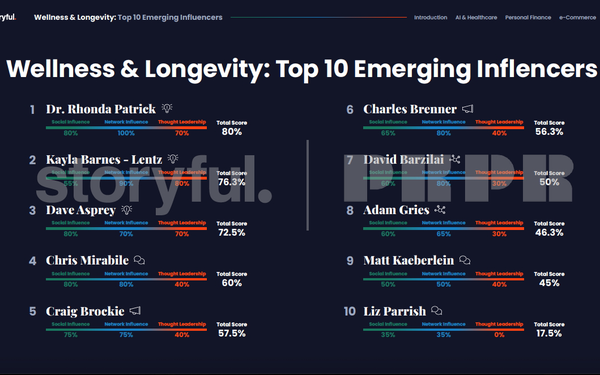
“Who's already influencing your
customer’s next decision?” asks the Emerging Influencer Index, released today by News Corp.’s Storyful.
The answers include Dr. Eric Topol and Dr. Rhonda Patrick, who came
out on top in their respective categories of “AI & Healthcare” and “Wellness & Longevity.”
If you recognize those names, consider yourself ahead of the curve
(and feel free to skip the next two paragraphs).
Dr. Topol is founding director of the Scripps Research Translational Institute. His YouTube
channel has only 8,000 subscribers, but saw 37% growth during the study period by “bridging AI and clinical practice.” His followers? Healthcare professionals, clinicians and
administrators, medical researchers and policymakers.
advertisement
advertisement
Dr. Patrick, host of the FoundMyFitness podcast, shares what the study calls
“evidence-based strategies backed by research, not hype…detailed insights on micronutrients, exercise and disease prevention through the lens of clinical science.”. During the study
period, she testified before the U.S. Senate Special Committee on Aging. Her followers? Biohackers, fitness enthusiasts and “those interested in optimizing healthspan and longevity.”
AI & Healthcare and Wellness & Longevity joined three other categories -- Personal Finance, E-Commerce and “Soccer” -- in what Storyful says are the first influencer rankings to
eschew follower counts in favor of thought leadership, accounting for 50% of its rankings: the impact the influencer has on driving conversation within the industry, measured by volume of
self-published communications, mentions in Tier 1 and Tier 2 media, and mentions on LinkedIn. Then there's network connectivity (25%) and social influence (25%).
Why those five
categories? They’re all areas with “a lot of activity and movement,” Tara Naugton, Storyful’s senior vice president of intelligence, tells Pharma & Health Insider.
She adds that other categories will be studied in the future.
And why combine AI and healthcare? “AI touches every industry and every behavior,” acknowledges Naugton, but “we
wanted an intersection that made sense, and there’s really compelling work being done in leveraging AI for healthcare.” Applications, she notes, range from diagnostics to modeling to
patient care.
“Our hope is to engage in and educate people on some of the conversations happening online so that healthcare brands, insurance companies or practitioners can determine how
it might be relevant to them,” Naugton explains. “If medical professionals are turning towards influencers for knowledge sharing, it’s good for healthcare companies to know
that and take on any learnings, messages or themes that might apply to their business.”
She continues: “If they’re emerging influencers that aren't on your radar,
you’re missing out on an opportunity for learning. These emerging voices could have a direct impact on how an audience thinks or feels about a brand.”
With Dr. Topol, for example,
“What is he talking about that’s resonating, who are the audiences he’s influencing, and are they relevant to my brand?...It can inform your campaign strategy, who you communicate
with, how much you understand what the audience is focused on.”
Naugton says that these emerging influencers, as opposed to “people that might be well recognized because they have
a long history of exposure through traditional editorial media or paid media,” can help healthcare brands “go really deep and understand what’s coming, what’s being said, and
what’s next. More healthcare companies should take advantage of the conversations happening online, to better inform your strategies to connect, to engage, to market a product, or to educate
around a specific drug.”
Furthermore, she said, brands can consider the emerging influencers for partnerships or “take the themes and stories they’re sharing and factor it
into your own planning. In other cases, you might just use it for information mining….They could give you themes and understanding that could influence your messaging, your positioning.
To come up with the top 10 emerging influencers in each category, the study analyzed conversations conducted from February through March of this year across X, Instagram, TikTok, Bluesky, YouTube,
LinkedIn and some 60 other platforms.
The specific media used, by the way, are integral in understanding how emerging influencers work in specific categories, the report finds
In this regard, Dr. Topol’s YouTube channel is an exception to the main medium of most “AI & Healthcare” emerging influencers: LinkedIn, which the report says predominates
because the target audience “values credibility over virality.”
Half the emerging influencers in the “Wellness & Longevity” space, on the other hand, favored
Instagram, “leveraging its image-centered format to embody the lifestyles they advocate and build trust around their content.”
“Each platform builds influence
differently,” the report continues, “highlighting the need for channel-native marketing. Repurposing content without adaptation dilutes impact.”